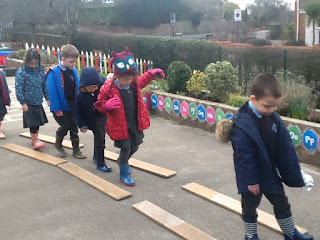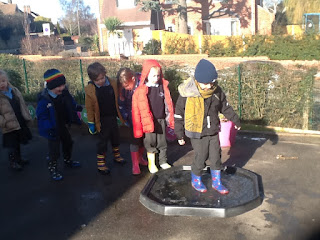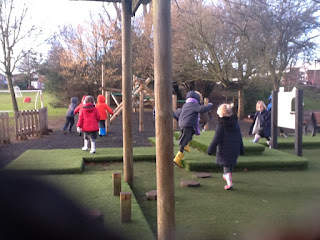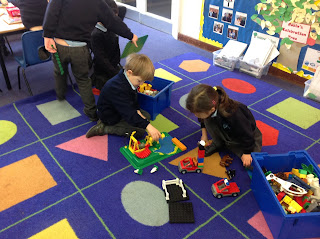Useful information and requests:
- Our Fairtrade café is on Thursday 1st of March. You are invited to join your child at our cafe to buy a fair trade drink and snack and we will sing you a song. The children will be making some chocolate krispies using fairtrade produce after half term. These will be on sale at the cafe.
- After half term please could we ask that the children's PE bags have jumpers and tracksuit bottoms removed as we do not need these at the moment (we are not going outside) and they are just extra things to get lost!
- Please ensure that all clothes are labelled as children often muddle up their clothes when they change for PE.
- Thanks for all the junk modelling- we have enough for at least the first week back!!
Things to do...
- Recap this weeks sounds-sh, th and ng
- Ask your child to find 3D shapes in the environment. Can they name the shapes and describe them? Can they tell you the 3D rhyme they learnt at school (see below).
- Read with your child
- Have a really good rest!
-
This week three of our adult directed tasks were linked to our theme of 'Pirates' to inspire the children's learning. The children received a letter from Captain Mollie who wrote that she had been out in the stormy seas and lost her treasure and belongings. She asked whether we could help her find it. The children looked through all the items that had been found in our classroom and then had to think about how they were going to tell the Captain about what they had found. The children decided that they needed to send messages to her. They thought of different things they could write in their message:
· A list of things we’ve found
· A message to her
· Describe an object
· A question
- say the word
- finger the word
- write the word.
The teacher then modelled how we could do this.
Each child wrote a message- a sentence, caption or drawing. We encouraged the children to use their phonics to help them write following our steps:
The children then rolled up their messages and put them in bottles to send to Captain Mollie.
In the second pirate activity the children sat in a circle with the pirate ship and a pirate figure in the middle. They started by playing a game of 'where is the pirate?' The pirate was moved around and the children were encouraged to use positional language to describe where the pirate was (behind it, next to it, on top of, under. inside, beside, below....). The children were then taken on a treasure hunt/ obstacle course and they had to continue to use the positional language to describe what they were doing. They tiptoed in between the planks, through the snake pit etc. Perhaps your child could describe what they were doing in the pictures below using positional language. At the end of the treasure hunt they each found a chocolate gold coin which they were allowed to bring home on Friday.
Another activity was based in the creative area, teaching the children how to make models with junk effectively and ensuring that the children think about the stages of model making.
We explained that they were going to using the
junk to make a model to fit into our pirate topic.
We asked them: What could we make related to pirates? Treasure chest, ship,
treasure island, sword, etc.
Key questions:
How do you want it to look?
What resources will you need?
How are you going to join them together?
What techniques are you going to use?
What are you going to cover the boxes with?
How would you change it next time?
The final adult directed activity was a maths activity with the focus of number formation for all numbers to 10. This consisted of a carousel of activities including:
- marble rolling in numbers,
- formation of numbers on a white board
- Number tracing with felt tips
- making number with 2 duplo pieces
The children rotated around four activities over the week.
At the beginning of every session we chanted a 3D shape song while holding the shapes:
Cube, cube, what’s your clue? - 6 square faces all over you
Cuboid, cuboid, what’s your clue? - You look like a tissue box achooo!
Cylinder, cylinder, what’s your clue? - You can stand up or roll about too
Sphere, sphere, what’s your clue? - You look like a ball that you kick with your shoe
Cone, cone, what’s your clue? - Don’t let your ice cream drip on you!
See if your child can chant it with you.
See if your child can chant it with you.
Activity 1: We explained that we were going on a shape hunt. We asked the children to find the shapes that were hidden outside and bring them back to the table and ‘sort’ them into the correct tray.
We told the children some shape
riddles that they had to solve – I have 6 square faces what am I?
I am roll like a ball, what am I?
I have two circular faces, what am I?
Activity 2: The children were given a picture of a 2d shape and they had to fit as many spheres/cuboids/cones, cylinders into the shape as they could counting them.
In phonics this week we introduced the sounds 'sh', 'th' and 'ng'. Focusing on reading for the first day and writing on the second day for each sound. See if your child can use their phoneme fingers or robot arms to sound out these words and their blending arm to blend them back together.
Your child could then have a go at writing some of these words.
sh: fish, ship, shell, shed, shop, wish
th: thin, thick, tooth, teeth, moth, think, three
ng- bang, song, sing, ring, king, gong, long, ping-pong
The children found 'th' particularly difficult. We practised saying 'th' and 'f' demonstrating how the shape of our mouth changes. When we say 'th' we stick our tongue out slightly. When we say 'f' we rest out top teeth on our bottom lip. It would benefit you child greatly if you practised differentiating these sounds and words beginning with these sounds.
We also practised the formation of these letters:
s- is a curly caterpillar letter. Make a curve, up, down, down and tick
t- is a long ladder letter. Start at the top, down and curve, up, down and flick.
h- is a robot arm letter. Start at the top, down, down, bounce half way back up, over and down and flick.
n- is a one armed robot letter. Start at the top, down, bounce back up and over, down and flick.


























































































































